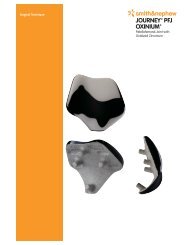Uni- Condylar Knee Surgical Technique - Yorkshire Joint ...
Uni- Condylar Knee Surgical Technique - Yorkshire Joint ...
Uni- Condylar Knee Surgical Technique - Yorkshire Joint ...
Create successful ePaper yourself
Turn your PDF publications into a flip-book with our unique Google optimized e-Paper software.
Distal Femoral Resection<br />
Goal: Distal femoral resection parallel to<br />
the tibial resection, using shims where<br />
appropriate.<br />
Shims<br />
Use shims in the following scenarios where<br />
appropriate with the distal cutting block<br />
(Figure 20).<br />
Figure 20<br />
Femoral defect shims (1 mm, 2 mm or 3 mm):<br />
use if excessive extension laxity exists relative to<br />
flexion. Use of these femoral defect shims will<br />
effectively under-resect the distal femur (removing<br />
less bone than is replaced by component<br />
thickness), tightening the extension gap in cases<br />
where distal femoral loss has occurred (Figure 21).<br />
Tibial shims (8 mm, 9 mm, 10 mm or 11 mm):<br />
Use if the 7 mm tibial trial was used in balancing,<br />
do not add a tibial shim to the tibial side of the<br />
distal cutting block. If a thicker tibial trial was<br />
used, add the appropriate tibial shim to the tibial<br />
side of the distal cutting block (Figure 22).<br />
Figure 21: Femoral shim added due to femoral defect.<br />
Figure 22: Tibial shim added for appropriate tibial insert thickness.<br />
12





